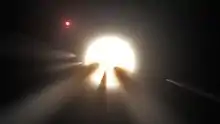Gliese 1132 b
Gliese 1132 b (also known as GJ 1132 b) is an exoplanet orbiting a red dwarf star Gliese 1132 40 light years (13 parsecs) from Earth,[1] in the constellation Vela. The planet is considered uninhabitable but cool enough to possess an atmosphere.[2] Gliese 1132 b was discovered by the MEarth-South array in Chile.[4]
 Gliese 1132 b | |
| Discovery[1] | |
|---|---|
| Discovered by | MEarth-South Array Team |
| Discovery site | Chile |
| Discovery date | May 10, 2015 (announced)[2] November 12, 2015 (confirmed)[3] |
| Transit | |
| Orbital characteristics | |
| 1.6 d | |
| Star | GJ 1132 |
| Physical characteristics | |
Mean radius | 1.2 R⊕ |
| Mass | 1.6 M⊕ |
| Temperature | 410 K (137 °C; 278 °F) |
It has been called "one of the most important planets ever discovered beyond the Solar System": Due to its relative proximity to Earth, telescopes should be able to determine the composition of its atmosphere, the speed of its winds and the color of its sunsets.[5][6][7] This is due in part to the small diameter of its parent star (20% that of the Sun), which increases the effect on the star's light of its transits. The planet's diameter is approximately 20% larger than that of the Earth[1] and its mass is estimated at 1.6 times that of Earth,[2] implying that it has an Earth-like rocky composition.[8] Gliese 1132 b orbits its star every 1.6 days at a distance of 1.4 million miles (2.24 million kilometres).[4]

The planet receives 19 times more stellar radiation than Earth.[1] The temperature of the top of its atmosphere is estimated at 500 °F (260 °C; 533 K). The planet is estimated to be hotter than Venus, as higher temperatures may prevail near the surface.[8] (cf. Atmosphere of Venus, Colonization of Venus) It is possible that one side of the planet is cooler, because it is presumed to be tidally locked due to its proximity to its star; however, under most circumstances where an atmosphere is thick, it would be able to transfer heat to the far side.
In April 2017, a hydrogen-dominated atmosphere was claimed to have been detected around Gliese 1132 b.[9][10] However, subsequent, more precise work ruled out the previous claim.[11]
References
- Berta-Thompson, Zachory K.; et al. (2015). "A rocky planet transiting a nearby low-mass star". Nature. 527 (7577): 204–207. arXiv:1511.03550. Bibcode:2015Natur.527..204B. doi:10.1038/nature15762. PMID 26560298. S2CID 4385619.
- Chu, Jennifer (November 11, 2015). "New exoplanet in our neighborhood". MIT News. Retrieved 2015-11-12.
- NASA Exoplanet Archive New ticker slide 1
- "Astronomers Eager to Get a Whiff of Newfound Venus-like Planet". Harvard–Smithsonian Center for Astrophysics. November 11, 2015. Retrieved 2015-11-12.
- Sample, Ian. "Earth-like world could be 'most important planet found outside solar system'". The Guardian. Retrieved 2015-11-11.
- Burgess, Matt. "Exoplanet GJ 1132b: the 'most important' ever found". Wired UK. Retrieved 2015-11-12.
- "Getting Up Close and Personal with an Earth-Sized Exoplanet". The Kavli Foundation. November 11, 2015. Retrieved 2015-11-13.
- Eva Botkin-Kowacki (2015-11-11). "Spotted: A rocky Earth-sized planet close by". The Christian Science Monitor.
- Atmosphere around super-Earth detected, April 6, 2017, retrieved April 6, 2017
- Southworth, John; et al. (2017). "Detection of the Atmosphere of the 1.6 M ⊕ Exoplanet GJ 1132 b". The Astronomical Journal. 153 (4): 191. arXiv:1612.02425. Bibcode:2017AJ....153..191S. doi:10.3847/1538-3881/aa6477. S2CID 119049452.
- Diamond-Lowe, Hannah; et al. (2018). "Ground-based Optical Transmission Spectroscopy of the Small, Rocky Exoplanet GJ 1132b". The Astronomical Journal. 156 (2). 42. arXiv:1805.07328. Bibcode:2018AJ....156...42D. doi:10.3847/1538-3881/aac6dd. S2CID 119061941.


